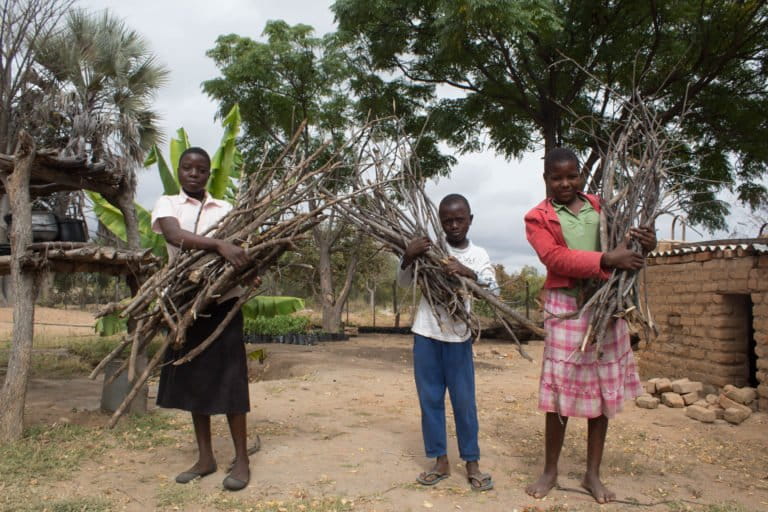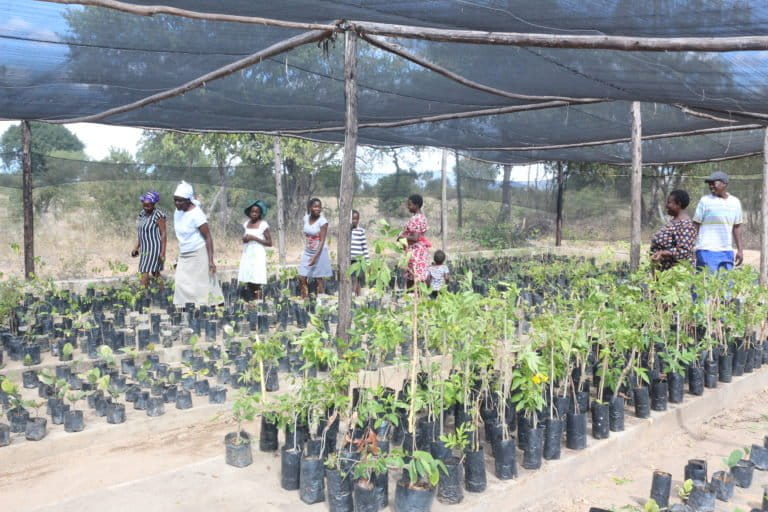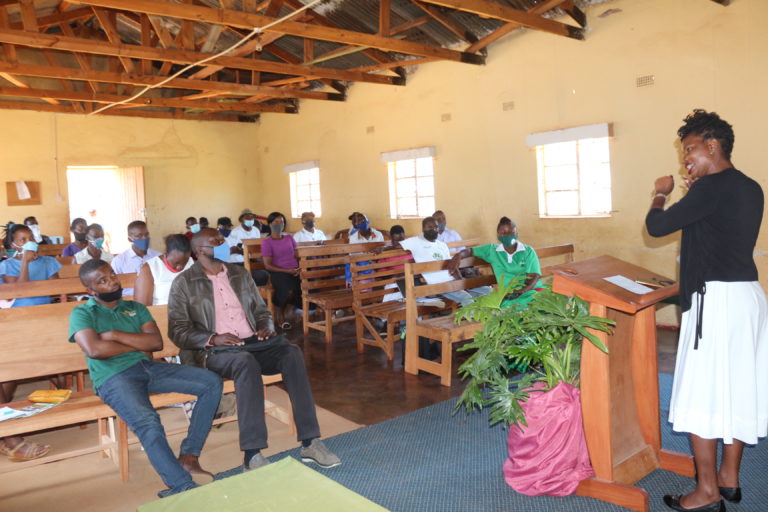Key points
- According to Shamiso Mupara, founder and executive director of Environmental Buddies Zimbabwe, climate change, droughts and food shortages are having a greater toll on women than men in rural Zimbabwe, as seen in the rise of forced marriages during the 1992 year of extreme drought.
- Growing up in a rural community affected by regular periods of drought, Mupara decided to dedicate her life to empowering Zimbabwean women and increasing their financial independence with environmental campaigns and beekeeping trainings.
- Due to land degradation, Mupara told Mongabay, women are finding it increasingly difficult to farm, feed their families or engage in meaningful forest-based businesses.
- One of the main solutions according to Mupara is demystifying climate change through education to make sure it’s not scary. Climate change discussions to her, present opportunities for communities to be engaged in green businesses such as biogas, solar, climate-smart agriculture, thereby creating employment.
HARARE, Zimbabwe – Women, children and the elderly are increasingly vulnerable to the effects of climate change in rural Zimbabwe, taking up a large share of the agricultural labor force and management of household nutrition. This became especially apparent in the years between 1950 and 2013, where the country recorded 22 years of drought, leaving millions in need of food aid.
In Marange, a rural area 257 kilometers (160 miles) east of Harare, the capital, the low rainfall, poor soils and severe dry spells during the 1992 drought hit all farmers hard. Most subsistence farmers watched their maize crops and livestock die, with no reprieve in sight. In total, over a million cattle died of starvation that year. Five million people were in need of food aid, while children suffered from malnutrition and kwashiorkor.
In order for families to survive, daughters were increasingly married off to older men in exchange for grain or livestock, providing families with enough to eat. In other instances, women would face starker repercussions of drought and land by the manner labor is divided.
While men, who are regarded as breadwinners, would relocate to urban areas in search of work, women, children and the elderly remained in rural areas to maintain fields and harvests increasingly vulnerable to the effects of climate change.

Shamiso Winnet Mupara, a young girl from Marange and aged nine during the 1991-1992 drought season, still bears the unpleasant memories of that fateful period.
“The first rains came in October 1991 for about two weeks and we planted our fields, but it did not rain until December,” Mupara told Mongabay in an interview. “By that time, all crops had died. We planted again in December, and the same thing happened. The rainfall was so erratic that we planted three times that season.”
Growing up, she accompanied her grandmother, a traditional medicinal practitioner, to harvest various herbs such as Dicoma anomala, used for indigestion. Since then, she cultivated an affinity and appreciation for Zimbabwe’s grassland ecosystem, a source of livelihood for the rural community.
Later on, when deforestation caused by a frenzy for timber exports and firewood wiped the nearby Mupara woodlots, she joined other girls her age and women in search of firewood and water, walking distances even further from their homes.
“Our day would start around 3:30 am, embarking on a trip of almost 10km to the mountains to look for firewood, and we had to be in class by 7:30 am,” said Mupara.
All these childhood memories went on to influence her dedication to found an environmental organization in 2012, Environmental Buddies Zimbabwe (EBZ), where she focuses on transforming the lives of women in poor, rural communities through reforestation initiatives and education.
Mupara has led the establishment of nurseries, the planting of over 10,000 native trees across the country and environmental campaigns and trainings for rural women. In 2022, she was designated as a fellow for the Women for the Environment Africa.

To get a deeper dive into how rural women are confronting the effects of climate change, deforestation, water scarcity, and droughts in Zimbabwe, Mongabay discussed these issues with Shamiso Mupara.
Mongabay: How has water scarcity, gullies, soil erosion and droughts impacted rural people in Zimbabwe, especially rural women?
Shamiso Winnet Mupara: Women in Zimbabwe and Africa are in constant contact with the natural environment during their daily chores of looking for water, firewood, wild fruits, and agriculture. Land degradation makes all the above resources scarce, in such a manner that women are now walking longer distances to look for them.
In some communities, women walk over 10 km (6 miles) to look for firewood and water. These chores usually take them the whole day leaving them with no time to do other meaningful activities such as entrepreneurship. Because of this, most of them remain poor.
Soil erosion, or the degradation of fertile topsoil and reduced infiltration rates, has seen agriculture yields decreasing, leading to food insecurity at a household level. Most families now rely on food aid from the government or international aid organizations.
Unselective deforestation has also seen the cutting down of fruit trees, and plants that support edible worms, insects, and small game which make up a bigger part of the rural diet. Women are finding it increasingly difficult to feed their families or engage in meaningful forest-based businesses such as beekeeping and community gardens due to land degradation.
Mongabay: What do rural women in Zimbabwe think about climate change and its related impacts?
Shamiso Winnet Mupara: Most rural communities are now acknowledging the reality of climate change and its negative impacts on them, the environment, and the rural economy. However, instead of most of responding by protecting the remaining natural resources and repairing those that are lost, they continue to degrade limited resources in a bid to feed their families.
As much as continued degradation can be blamed on poverty, I also think a lack of knowledge on climate change is at play. Most communities are aware that climate change is there but they do not know how to respond to it.

There is a feeling of despair, hopelessness for no one knows what the future holds. No one knows whether more cyclones will destroy their homes and force them to migrate, or when droughts will get worse and impact their ability to feed their families. In the midst of all this, educated women on climate change adaptation and resilience have tried taking the lead in programs such as climate-smart agriculture.
In Marange communal area, communities have resorted to growing drought-resistant grains such as millet (Pennisetum glaucum), sorghum (Sorghum bicolor), and also other drought-resistant crops such as cassava (Manihot esculenta).
Mongabay: Tell us more about the Environmental Buddies Zimbabwe (EBZ) organization and how it incorporates rural women’s issues?
Shamiso Winnet Mupara: Being a female-led organization, one of our key objectives is the empowerment of women and girls through reforestation. Bringing forests closer to rural communities enables girls to quickly complete their daily chores of collecting firewood, thereby allowing and encouraging them to stay in school for longer periods and engage in other income-generating projects.
It further empowers women to sustain themselves in related industries such as beekeeping and jewelry-making, thereby creating female independence and reducing poverty.
The organization has been sponsoring female students at Buwerimwe Secondary School since 2019. A total of 5,000 women have been reached through our environmental education and awareness program in four different provinces of the country. In 2020, 100 women from Mutare, 263 km (163 miles) from Harare, were trained in beekeeping as part of the female empowerment program. Since 2012, we have seen more women gaining interest in planting trees, especially fruit trees at their respective households.
The EBZ intends on promoting the planting of indigenous trees throughout the country by 2030 as a poverty reduction mechanism and to create a platform for participation of underprivileged members of the society irrespective of gender.

Earlier in our project, we used to just distribute trees at various gatherings hoping community members will go and plant them. We then realized that one would take a tree because it’s free, but they never bothered to plant or take care of them, as a result, most trees died.
We then later introduced education and awareness in our project, as a means to generate interest in environmental stewardship. This has worked like magic. Now communities have changed their attitude towards tree planting and are willingly coming to our offices to request trees to plant.
Up to now, education and awareness campaigns have reached over 10,000 communities including 20 schools across the country. Seventy percent of participants of our capacity-building programs are females especially in beekeeping and community gardening. We currently have seven students, two women and five men, under our Felix Mupara Scholarship from primary to post-secondary level.
We also have technical partnerships with United States Forest Services, Forestry Commission and Environmental Management Agency who support us with a range of services. This includes how to raise nurseries, manage planting areas and communicate environmental Acts, laws and policies in Zimbabwe to communities.
Mongabay: Do you recall the first time you felt a connection to Zimbabwe’s rural environment?
Shamiso Winnet Mupara: I grew up in Marange communal area. From day one, I was a girl who loved nature. My paternal grandmother, who came from a family of herbalists, would take me into the mountains to harvest medicinal roots, leaves and tree bark from the moment I could walk. From there, I engaged in normal activities for women, such as herding livestock, agriculture, looking for firewood, looking for wild fruits and water.
We used to cut down trees with no effort to replace them. As trees became scarce nearby our homesteads, we had to walk long distances to look for firewood. Our day would start around 3:30 am, embarking on a trip of almost 10km to the mountains to look for firewood and we had to be in class by 7:30 am.
I also experienced the effects of the 1991-1992 drought, which left the whole community in despair as we all watched our livestock die, water sources dry up, and the worst of them all, families marrying off their young daughters to put food on the table.

When the drought occurred, I was around nine years old. I remember it did not rain much that year. The first rains came in October 1991 for about two weeks and we planted our fields, but it did not rain until December. By that time, all crops had died.
We planted again in December, and the same thing happened. The rainfall was so erratic that we planted three times that season. By October, the peak of the summer season, the few water sources especially for livestock were drying up, and we had to walk long distances to get drinking water for our livestock.
By the time we got to January of 1992, cattle started dying from both starvation and thirst. There was no food anywhere and the temperatures got hotter by the day. Very few families were able to get two meals a day. Most families went for days without food.
Wild fruits such as baboon fruit (Strychnos spinosa), fruits from the mupundu tree (Parinari curatellifolia) and marula Scherocarya birrea comprised the major diet for the community. Most toddlers were showing signs of malnutrition and kwashiorkor. This is when families married off girl children to get food, a cultural practice done in some parts of Zimbabwe.
Mongabay: What is do you believe people in Zimbabwe should start doing today to restore their rural ecosystems?
Shamiso Winnet Mupara: The communities must protect, preserve and repair forests, they are the umbilical cord that holds our lives together. This will include activities such as tree planting and digging rainwater harvesting pits to keep soil moisture. This includes stopping stream bank and river bed agriculture because it’s affecting the quantity and quality of water. They must limit brick molding and firewood businesses as it further puts pressure on already fragile forests.
In addition, they need support to start forest-based non-timber products such as beekeeping, wild fruits harvesting and processing, fisheries, and piggery, to mention a few. In Marange, the EBZ is promoting community gardens, planting fruit trees and training communities in beekeeping to creating employment for women and youths, while ensuring food security at the household level.
Other initiatives such as those by the Grow a Tree Foundation have planted 2,000 moringa trees (Moringa oleifera) and 2,000 pawpaw (Asimina triloba) trees for food. Over one hundred women and youth have been employed in the project.
Mongabay: How do you promote environmental protection in Zimbabwe without sounding catastrophic and scaring community members away from action?
Shamiso Winnet Mupara: Education and awareness are the first steps. We need quality education for our communities. Quality education is just education fit for purpose. In the wake of climate change, more resources must be channeled in that direction to create a platform where information is shared among stakeholders – communities included.
Communities fear what they don’t know. Demystifying climate change through education is what is needed to make sure it’s not scary. While climate change sounds scary, it also provides opportunities for communities to be engaged in green businesses such as biogas, solar, climate-smart agriculture, thereby creating employment.
Mongabay: What do people often misunderstand about forests and droughts, and how do you seek to address it?
Shamiso Winnet Mupara: Often, people do not link forests with temperatures, rainfall patterns, agriculture yields and water availability. A lack of trees or forest cover results in high temperatures, lack of soil moisture, a lack of evapotranspiration and lack of rainfall.
Without forests or plants, there are reduced infiltration rates, no soil moisture, water stress for plants, reduced crop yields. Lack of forests or plants means there is no infiltration, no recharging of underground storage, wells drying up fast, water scarcity, and women walking long distances to look for water.
Encouraging communities to plant trees to address the following is an uphill battle, but I always put it out there. I always bring teaching aids such as pictures and drawings to link these impacts to land degradation to ensure communities understand the science of land degradation and negative its impacts.
Read original article here.

